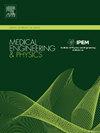Efficient digitally reconstructed radiographs with middle-out rendering and convex hull-based early stopping
IF 2.3
4区 医学
Q3 ENGINEERING, BIOMEDICAL
引用次数: 0
Abstract
Kinematic tracking of native anatomy in dynamic radiography facilitates understanding of in vivo movement. Tracking is performed using model-image registration, which involves estimating 6 degree-of-freedom poses of anatomic structures by comparing captured radiographs to dynamically rendered images of digital models. This procedure can produce accurate pose estimates of native anatomy, but computational efficiency remains a concern. A key source of latency in model-image registration is the iterative rendering of digitally reconstructed radiographs, required for evaluation of candidate poses. This technical note introduces an efficient algorithm for rendering digitally reconstructed radiographs. The proposed method is shown to accelerate rendering speeds by up to 50% compared to a baseline method which is commonly used in registration frameworks. Efficient rendering of digitally reconstructed radiographs may enhance the overall viability of model-image registration for use in kinematic tracking, and may contribute to bringing this technology closer to adoption in clinical settings.
有效的数字重建x线照片与中间渲染和凸壳为基础的早期停止
动态x线摄影中原生解剖的运动学跟踪有助于理解体内运动。使用模型-图像配准进行跟踪,其中包括通过比较捕获的x光片和数字模型的动态渲染图像来估计解剖结构的6个自由度姿势。这个程序可以产生准确的姿态估计的本地解剖,但计算效率仍然是一个问题。模型图像配准延迟的一个关键来源是评估候选姿态所需的数字重建射线照片的迭代渲染。本技术笔记介绍了一种有效的算法,用于呈现数字重建的射线照片。与注册框架中常用的基线方法相比,所提出的方法可以将渲染速度提高50%。数字重建x线照片的高效渲染可以提高模型图像配准在运动学跟踪中的整体可行性,并可能有助于使该技术更接近于临床应用。
本文章由计算机程序翻译,如有差异,请以英文原文为准。
求助全文
约1分钟内获得全文
求助全文
来源期刊

Medical Engineering & Physics
工程技术-工程:生物医学
CiteScore
4.30
自引率
4.50%
发文量
172
审稿时长
3.0 months
期刊介绍:
Medical Engineering & Physics provides a forum for the publication of the latest developments in biomedical engineering, and reflects the essential multidisciplinary nature of the subject. The journal publishes in-depth critical reviews, scientific papers and technical notes. Our focus encompasses the application of the basic principles of physics and engineering to the development of medical devices and technology, with the ultimate aim of producing improvements in the quality of health care.Topics covered include biomechanics, biomaterials, mechanobiology, rehabilitation engineering, biomedical signal processing and medical device development. Medical Engineering & Physics aims to keep both engineers and clinicians abreast of the latest applications of technology to health care.
 求助内容:
求助内容: 应助结果提醒方式:
应助结果提醒方式:


